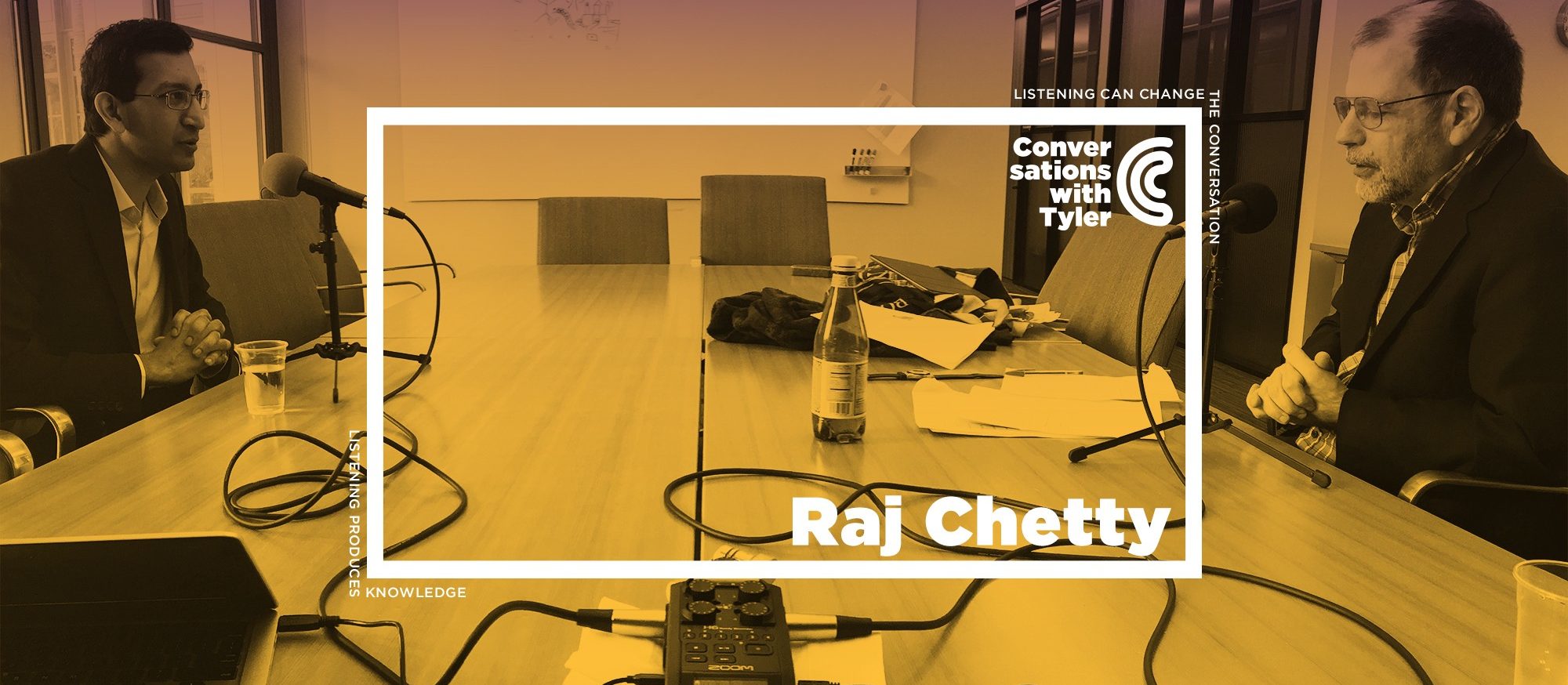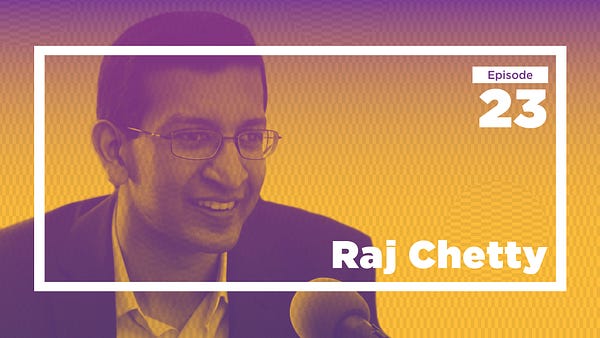COWEN: It’s like a Giffen good. It’s more of a signal then.
Some European systems such as Germany, they have much more extreme forms of tracking than we do. So you get put on an on-college track. You are evaluated early. What’s your opinion of those systems?
CHETTY: My feeling is too much tracking at an early age is detrimental because children bounce around. Test score measures are imperfect. There is no way you can perfectly gauge a person’s trajectory at a very young age. However, I think there’s some exceptions to that. At the very upper end of the distribution, gifted and talented programs, I think there is good evidence suggesting that they can be extremely effective in promoting those kids. Learning and getting them on a path to be kind of the superstars in the economy who are starting the new companies, discovering the new drugs, and so forth.
So, while I would not advocate tracking at the broadest level across 95 percent of the distribution, I think there can be a role at the very top to give attention to gifted and talented kids, especially, I would say, from disadvantaged backgrounds, where often you don’t have the stimulation and the resources, if you’re a very smart kid at an early age.
COWEN: Is there a tension here with your own work? Because part of what you are doing is trying to explain, or you could almost say predict, the mobility children will experience. And that’s fairly well predicted. We might think it’s wrong that it can be predicted as well as it is, but people actually don’t move to better neighborhoods as often as we would like.
Isn’t, in a sense, that work potentially a rationale for tracking? Not a normative — this isn’t the way the whole world should look — but in the sense of we can identify these children, run them through the Chetty equations, and then track them. Yes, no?
CHETTY: To some extent, but that’s why I was emphasizing the upper tail. I’m not convinced we can actually identify these children in terms of their potential outcomes at a very early age with a great deal of accuracy. I think there’s some predictive power. You can explain maybe a quarter of the variation that you’d see in adulthood with early childhood test scores and things like that. There’s certainly strong predictors, but by no means are they . . . They don’t tell you your fate.
There’s lots of variation even conditional on how well you’re doing early in childhood. So it’s important to recognize that and not condemn people to different tracks purely based on how they are doing at the earlier stages. Again, with the possible exception of kids in the upper tail, where I think it requires a lot of investment to get children to the point where they’re going to be highly productive members of society — having positive spillovers on others — and so there is a rationale to potentially invest there.
COWEN: What’s the most memorable thing a K–12 teacher did for you?
CHETTY: Well, I remember in high school being influenced by a number of teachers. One anecdote that comes to my mind off the top of my head, in the context of this conversation, is a history teacher I had who taught an economics class in my high school. He said, “You know, Raj, one day you are going to be on the Federal Reserve Board.” And I remember thinking to myself, “There is no way because I am going to do biomedical science. This teacher clearly doesn’t know my interest.” And I look back upon that and think, “Well, he must have thought that I would be good at economics or interested in economics or something.”
On things under- and overrated
COWEN: There’s a segment in all of these conversations, in the middle; it’s called overrated or underrated. And I’ll toss out a thing, a name, a something, and you feel free to tell us if you think it’s overrated or underrated, and you are free to pass on any of these, of course.
First would be the Mozart of Madras, A. R. Rahman, the Indian musician. Overrated or underrated?
CHETTY: I’d say underrated.
COWEN: Why?
CHETTY: I think he’s had a huge influence on Indian music and bringing it to the Western world in particular. And I like his music very much.
COWEN: What about it speaks to you?
CHETTY: What about it speaks to me? I think the combination of Eastern and Western influences on music. Where there is more of a beat basically in Western music than in traditional Tamil and Carnatic music, and A. R. Rahman really was the person who saw how to bring those together.
COWEN: Many westerners know Bollywood, but Tamil cinema actually produces quite a few films. Overrated or underrated?
CHETTY: Overrated.
COWEN: Why?
CHETTY: Because there tends to be very little variety in what those movies are about, at least traditionally. It’s typically about marriage. That’s what a lot of these movies revolve around, and arranged marriages, and kids not wanting to have a particular arranged marriage, and ending up in a different situation. There is kind of a recipe to a lot of these movies.
COWEN: Given your work on mobility and all the data you have looked at, what do you feel is the most underrated state in the United States?
CHETTY: Utah.
COWEN: Utah. Why?
CHETTY: Salt Lake City, Utah, is maybe not a place you’d think of as having the most vibrant economy and so forth, but it’s a terrific place for upward mobility. It always shows up in the top of our data in terms of rates of upward mobility, health outcomes — lots of different dimensions. Maybe it makes sense ex post when you think about things like the community and the Mormon Church and so forth. But certainly ex ante going into it, if you had asked me, where do you think the place with the highest upward mobility is going to be, I would not have said Utah.
COWEN: I’ve often argued more Mormonism would be good for this country.
CHETTY: [laughs] Right.
COWEN: And good for the middle class.
Atul Gawande, and indeed your mother, I think, actually endorsed this idea in an interview: the notion that you get things done by having a checklist and checking them off as a way of being more productive. Overrated or underrated?
CHETTY: Underrated.
COWEN: Why?
CHETTY: Checklists I think are incredibly useful to stay organized and solve complex problems. The way to make progress on complex research problems, for example, is to divide them into smaller, manageable problems, and then go down a list and solve that checklist.
COWEN: In music, the group the Piano Guys, speaking of Mormons. Overrated or underrated?
CHETTY: Underrated. I love the Piano Guys.
COWEN: Why?
CHETTY: I think the Piano Guys are great in terms of doing renditions of popular songs.
COWEN: Not too triumphalist? Do you mean the major chords?
CHETTY: Maybe in some cases, but I like them.
COWEN: Bhindi or okra. Overrated or underrated?
CHETTY: [laughs] Underrated.
COWEN: [laughs] I’m also a fan. What’s the best way to cook it?
CHETTY: There are many Tamil preparations of okra. It’s a popular dish and supposedly, it’s supposed to make you smarter. So I ate a lot of okra when I was a kid, trying to get that.
COWEN: So let’s say a friend of yours, non-Indian, is going to make a trip to India; maybe they’ve even been there before. And they ask you, “Where should I go, other than the obvious sites, Taj Mahal and Mumbai?” Plenty of obvious things they might do. But they want a tip from you about how to better appreciate, understand, see India. What place would you recommend to them? And what insight would you package along with that recommendation?
CHETTY: I would say the South. I think most westerners’ perception of India is based on North India: Taj Mahal, Delhi, Agra, so forth.
But going to places in Tamil Nadu, going to places in Karnataka, increasingly . . . If you think about Silicon Valley, the corresponding place in India is in Hyderabad and the tech sector there. If I were to pick a specific place, the area where I’m from, there’s a city called Madurai in Tamil Nadu, which is a typical Tamilian city, and you get a very different feel for what India is relative to what you’d see in Delhi.
What is striking is that India is really a combination of many different countries, but completely distinct languages, completely different food, culture, and customs, and so forth. So what I would suggest is visiting at least two or three different states so you can see the diversity in the country.
COWEN: Chennai is actually my favorite Indian city, it may please you to know. So I agree with that.
As you probably know, in the history of South India, there’s this long-standing tradition of mathematical prodigies. Your work isn’t exactly mathematical, but broadly speaking, of course, it is. And why is it you think there’s this connection between South India and this history of mathematical prodigies? Do you have any thoughts on that? Is it something about the abstract nature of the philosophical thinking embedded into South Indian Hinduism?
CHETTY: Yes, it could be. The name that comes to mind most prominently is Ramanujan, The Man Who Knew Infinity . And I think that type of thinking is encouraged once you have a tradition of people in that vein. I remember hearing a lot about Ramanujan since I was a little kid. And so you look up to that kind of thing, and maybe that influences subsequent generations of children as well. I think that kind of mechanism is actually extremely important in terms of what children choose to do.
COWEN: There are a number of writers, as you know, who’ve tackled the highly diverse Indian American experience. One of them is Jhumpa Lahiri, who’s actually been a guest on this podcast series. But of that whole literature, who or what in it speaks to you the most, given that you have your own Indian American history?
CHETTY: There are a bunch of books that broadly focus on integration of Indians in Western society and what that entails and how different America is from India. What speaks to me is that there are obviously quite significant differences between the two cultures.
But the experience I’ve had is that America’s been an incredibly welcoming place since I was a kid. When I first came to the United States, it took some time to adjust, as it would for any child coming from a completely different background. But I found, on the whole, Americans to be very interested in Indian culture and to be very welcoming. That’s the experience I’ve had. I know other people have had different experiences, but to me that’s the main thing I think of.
COWEN: In 1969, your father published a pretty well-known piece in the American Economic Review, called “On Measuring the Nearness of Near-Moneys.” And it implies there are a lot of close substitutes for moneys. So, in light of this, given that India has recently tried a demonetization, which has been highly controversial — the Indian demonetization, would you say underrated or overrated?
CHETTY: I’ll have to pass because I don’t have a good sense. [laughs]
On drivers of upward mobility
COWEN: Let’s go now to some of your research on mobility, which is maybe, at this moment, what you’re best known for. You can identify counties or parts of the United States where mobility for generations is going to be especially high. To what extent do you think that’s picking up that simply some of those regions end up with resource booms or other good events that is, in a sense, just random? It doesn’t per se have to do with the region? Or do you think we can adjust for that?
CHETTY: Yes. Some of what drives upward mobility, of course, is just having a very vibrant economy. To give you an example, parts of North Dakota, with the natural resource boom there, we see are having very high upward mobility. Of course if you discover natural resources, that’s going to help more people move up the income distribution.
But by and large, that is the exception rather than the key driver of the differences in upward mobility that we find across places. I say that for a couple of reasons. First, even if you hold fixed the rate of growth, the rate of economic growth, you find that some places have much higher rates of upward mobility than others.
To give you an example, Atlanta is a city that’s booming in terms of jobs and economic growth overall. But Atlanta’s one of the places with the lowest levels of upward mobility for kids growing up in low-income families there.
The second thing you see is these rates of upward mobility, to the extent we have data, they tend to be quite persistent overtime. It’s not like the places that have high upward mobility in one decade, suddenly a very low upward mobility in the next decade. It’s a pretty persistent phenomenon.
A striking example of that is states in the middle of the US, like Iowa for example, which historical data going back to work by Claudia Goldin and Larry Katz has always looked like a place with very good outcomes for kids in lower-income families. And what’s amazing about that is, Iowa suffers from a brain drain phenomenon where the most successful people often end up leaving the state, going to Chicago, going to New York, to get higher-paying jobs. Yet generation after generation, Iowa seems to produce very good outcomes for low-income families. So that again suggests it’s not about natural resources or temporary booms. It’s something more persistent.
COWEN: And getting back to the kindergarten teacher question. The physical mechanism as it operates through geographic space, what does Iowa do to you, so to speak?
CHETTY: Yeah.
COWEN: If you told the story about molecules impinging on your body and impelling you to action, what’s the best story you can come up with for Iowa, say, or Utah?
CHETTY: Yeah, a few different things. Iowa is known for having very good public schools for a long time.
COWEN: But that too is arguably just part of the package.
CHETTY: Yes. Where did that come from? Why does Iowa have good public schools?
COWEN: Right.
CHETTY: One of the strong correlates we find is that places that are more integrated across socioeconomic groups, that have lower segregation, tend to have better outcomes for kids. And that kind of thing in a rural area — you can see why that occurs and why it might lead to better outcomes.
If you live in a big city, it’s very easy to self-segregate in various ways. You live in a gated community, you send your kids to a private school. You essentially don’t interact with people from different socioeconomic classes. If you live in a small town in Iowa, pretty much there’s one place your kids are going to go to school. There’s one set of activities that you can all participate in. And that is likely to lead to more integration.




